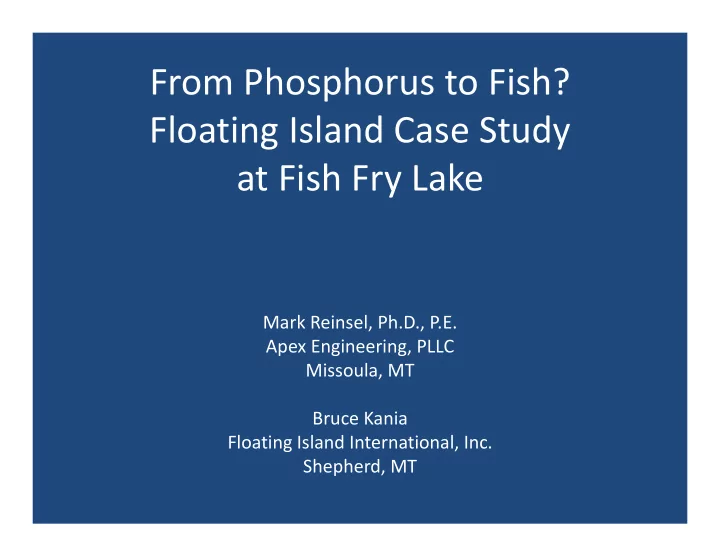

From Phosphorus to Fish? Floating Island Case Study at Fish Fry Lake Mark Reinsel, Ph.D., P.E. Apex Engineering, PLLC Missoula, MT Bruce Kania Floating Island International, Inc. Shepherd, MT
Topics • Nutrient issues • Floating islands for nutrient removal • Biological harvesting for phosphorus reduction • Other water quality improvements due to floating islands
Nutrient Reduction Issues New Total Maximum Daily Load (TMDL) – standards being implemented by EPA/DEQ across the nation for nitrogen and phosphorus – Compliance may cost Montana municipalities as much as $1 billion – “Nutrient trading” may be cost ‐ effective for larger Montana municipalities – Floating islands can serve as “polishing” treatment step and can provide platform for biological harvesting
What are Floating Treatment Wetlands (FTWs)? • Constructed of post ‐ consumer polymer matrix • Foam added for initial buoyancy • Typically planted with native vegetation • Two variations: BioHavens (2005): Static system Leviathan (2010): Aeration + circulation
Add plants and surface area is increased, and synergies between chemistry and biology are enhanced
Extensive root system (New Zealand)
Leviathan • Floating Treatment Streambed • Also constructed of post ‐ consumer polymer matrix • Typical thickness = 25 inches • Surface area = 300 ft 2 /ft 3 • Up to 35 acres of surface area
Montana FTW Studies • Fish Fry Lake (Shepherd): lake restoration • Rehberg Ranch (Billings): wastewater • Metra Park (Billings): stormwater • City of Billings: wastewater • Other Montana connections: – Funding from Montana Board of Research and Commercialization Technology – Working with MSU Center for Biofilm Engineering
Fish Fry Lake • 6.5 acres • Impacted by agricultural effluent • Average depth = 9 ft; max. depth = 30 ft • BioHavens: 7000 ft 2 • Leviathan: 1250 ft 2 • Nutrient loading, turbidity, stratification
FISH FRY LAKE WATER FLOW AND AERATION/CIRCULATION Date implemented 7/6/10 April ‘09 7/12/10 6/15/10 7/12/10 Diffuser Diffuser Leviathan (200 Fountain Diffuser (200 gpm) (2000 gpm) (400 gpm) gpm) Upper Ditch (variable flow) Wetland Lake Groundwater (80 gpm) General direction of water flow (approx. 80 gpm average)
Fish Harvesting Intensive fishing on FFL began in May 2011 – – Experienced fishermen catch 1 fish/2 minutes – Example on 10/13/11: Owner and friends caught 166 perch weighing 35 pounds – Total harvest in 2011 = 422 lbs. (8.1 lbs/wk) – YTD harvest in 2012 (thru 9/23) = 1091 lbs. (28.7 lbs/wk thru 38 wks)
Fish Size Fish Fry Lake Jackson Study inches mm (mm)* Ratio Age 1 6.7 170 126 135% Age 2 8.7 221 186 119% Age 3 10.8 274 236 116% Age 4 12.5 318 264 120% * 95th percentile data for North American yellow perch from Jackson & Quist (1991)
P Removal Via Fish • Phosphorus inflow – 0.041 mg/L * 80 gal/min = 0.276 lbs P/wk • Phosphorus harvest via fish – 28.7 lbs/wk * 1 lb P/100 lbs fish = 0.287 lbs P/wk • Harvest/Inflow = 0.287/0.276 = 104% • For average fish weighing 0.25 lb, 220 min/wk (3.7 hrs/wk) of fishing time is required to keep up with incoming phosphorus
Additional Harvesting • Fish: 1% P by live weight = 10.7 lbs P • Bullfrogs: Assume 1% P by live weight – 224 harvested in 2012 YTD – 101 lbs = 1.01 lbs P • Weeds: 0.1% P by wet weight – Coontail, musk grass, water nymph – 93.5 canoe loads in 2012 YTD = 37,400 lbs = 37.4 lbs P
Water Quality Effects in Fish Fry L. Nitrate ‐ N: 0.55 mg/L 0.01 mg/L – Phosphate ‐ P: 0.041 mg/L 0.025 mg/L – – Water clarity improved from 14 inches of visibility (2008) to 19 feet (winter of 2011)
BEFORE
AFTER
Temperature/DO Results • Stratification essentially eliminated • Livable zone for trout dramatically increased
Fish Fry Lake -- Dissolved Oxygen and Temperature Improvements 12 75 70 10 T Improvement 65 8 Temperature (Deg F) 60 DO (mg/L) 6 55 4 50 DO Improvement 2 45 0 40 0 5 10 15 20 25 Depth (ft) Dissolved Oxygen 2009 Dissolved Oxygen 2010 Temperature 2009 Temperature 2010
25 Maximum Livable Depth for Yellowstone Cutthroat Max. Depth (ft) at Which DO Exceeds 5.5 mg/L 20 15 2009 2010 10 5 0 Week 1 Week 2 Week 3 Week 4 July Data
QUESTIONS? Mark Reinsel mark@apexengineering.us (406) 493 ‐ 0368
Recommend
More recommend